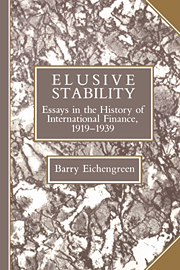Book contents
- Frontmatter
- Contents
- List of tables
- List of figures
- Acknowledgments
- 1 Introduction
- 2 Real exchange rate behavior under alternative international monetary regimes
- 3 Understanding 1921–1927: inflation and economic recovery in the 1920s
- 4 Bank Rate policy under the interwar gold standard
- 5 The Bank of France and the sterilization of gold, 1926–1932
- 6 International policy coordination in historical perspective: a view from the interwar years
- 7 The economic consequences of the franc Poincaré
- 8 Sterling and the tariff, 1929–1932
- 9 Exchange rates and economic recovery in the 1930s
- 10 The gold-exchange standard and the Great Depression
- 11 Hegemonic stability theories of the international monetary system
- References
- Index
7 - The economic consequences of the franc Poincaré
Published online by Cambridge University Press: 21 March 2010
- Frontmatter
- Contents
- List of tables
- List of figures
- Acknowledgments
- 1 Introduction
- 2 Real exchange rate behavior under alternative international monetary regimes
- 3 Understanding 1921–1927: inflation and economic recovery in the 1920s
- 4 Bank Rate policy under the interwar gold standard
- 5 The Bank of France and the sterilization of gold, 1926–1932
- 6 International policy coordination in historical perspective: a view from the interwar years
- 7 The economic consequences of the franc Poincaré
- 8 Sterling and the tariff, 1929–1932
- 9 Exchange rates and economic recovery in the 1930s
- 10 The gold-exchange standard and the Great Depression
- 11 Hegemonic stability theories of the international monetary system
- References
- Index
Summary
Introduction
The macroeconomic performance of the French economy in the 1920s contrasts sharply with cyclical experience in the rest of the industrialized world. French gross domestic product and industrial output grew with exceptional vigor over the first half of the 1920s (see Table 7.1). After a recession in 1926–27 and despite a noticeable deceleration in the rate of economic growth, through the end of the decade the French economy continued to expand at a rate significantly in excess of the international average. Well into calendar year 1930, France remained immune to the effects of the Great Depression, and even in 1931 the downturn remained moderate compared to other parts of the world. But once the full effects of the Depression were felt, its impact in France was exceptionally severe; as late as 1938 gross domestic product had not recovered to 1931 levels.
Accounts of the interwar period attach more weight to the exchange rate than to any other variable affecting the French economy's macroeconomic performance. Histories of the period 1919–26 are dominated by “the battle of the franc,” when financial difficulties culminating in the loss of 80 percent of the currency's external value greatly stimulated the export industries and macroeconomy. The period 1926–31 is characterized as the golden era of the “franc Poincaré,” when exchange-rate stabilization at an undervalued parity enhanced the competitiveness of French exports, stimulating growth through the end of the decade and insulating the economy from the onset of the Great Depression.
- Type
- Chapter
- Information
- Elusive StabilityEssays in the History of International Finance, 1919–1939, pp. 153 - 179Publisher: Cambridge University PressPrint publication year: 1990



